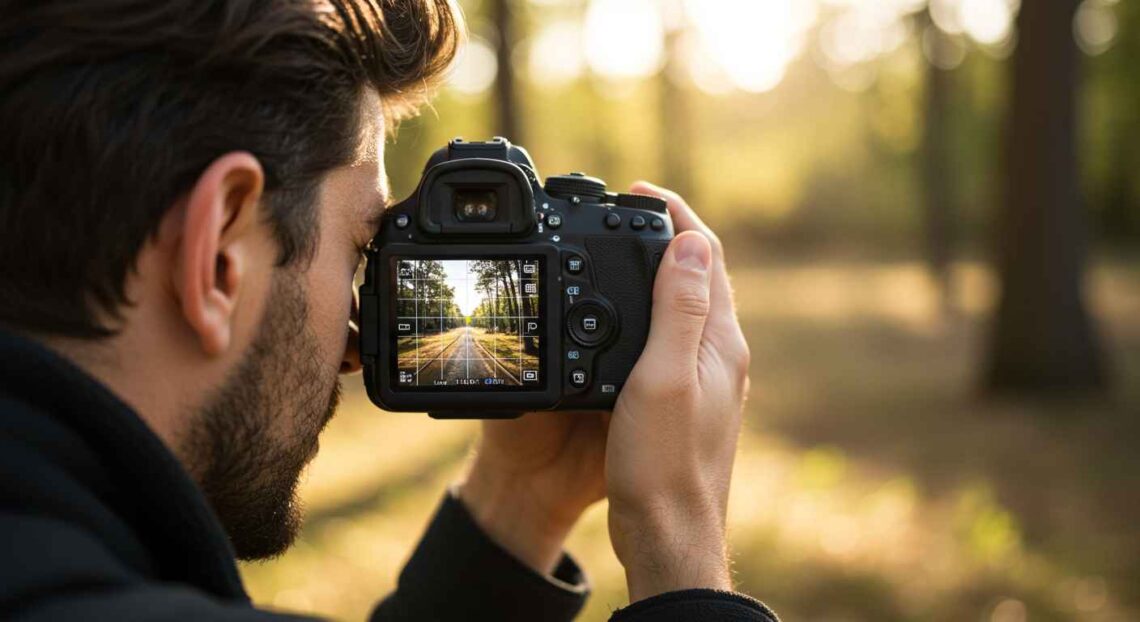If you want to take stunning photos that instantly grab attention, learning composition rules is the key. You don’t always need an expensive camera — even with your smartphone, applying the right composition can make your images look professional and artistic.
In this guide, we’ll explain the most important photography composition rules every beginner should know, along with easy examples and tips to help you improve your visual storytelling.
What Is Composition in Photography?
Composition is how you arrange the elements in a photo — your subject, background, colors, lines, and shapes — to create a balanced and appealing image.
It’s not just about what you shoot, but how you frame it.
Good composition helps your viewers focus on the most important part of your photo and makes it more visually interesting.
Think of composition as the language of visual design — it tells your story without words.
Why Is Composition Important?
Even the best camera can’t fix poor composition. The way you place your subject, manage space, and use light all affect the emotion and impact of your photo.
Here’s why composition matters:
- 🎨 Makes your images more artistic and professional
- 👀 Directs attention to the subject
- ⚖️ Creates visual balance and harmony
- 🧠 Tells a story and evokes emotions
- 📷 Helps you stand out on social media or photography platforms
1. The Rule of Thirds
This is one of the simplest and most powerful photography rules.
Imagine your frame divided into nine equal parts using two horizontal and two vertical lines (like a grid). Place your main subject on one of the intersecting points, not in the center.
✅ Why it works:
It makes the photo more dynamic and natural because our eyes are drawn to off-center subjects.
Example:
- Place a person on the left line instead of the center.
- Capture a sunset where the horizon sits on the bottom third line.
📱 Most phone cameras even have a “grid” option — turn it on and practice this rule!
2. Leading Lines
Leading lines are visual paths that guide your viewer’s eyes toward the subject.
They can be roads, fences, rivers, or even shadows.
✅ Why it works:
It adds depth and direction, pulling the viewer into the scene.
Example:
- A bridge leading toward a sunset
- A road leading toward a mountain
- A hallway pointing to a person at the end
Use lines creatively to lead the eye toward your main point of interest.
3. Framing Your Subject
Framing means using natural or man-made objects to create a frame around your subject — like a window, archway, or tree branches.
✅ Why it works:
It draws attention to your subject and adds a sense of depth and focus.
Example:
- Photograph someone through a car window
- Capture a landscape framed by trees or buildings
This technique makes your photos look cinematic and intentional.
4. Symmetry and Balance
Symmetry means both sides of your image look evenly balanced. It’s visually pleasing and gives a sense of calm and order.
✅ Why it works:
It appeals to our natural sense of harmony.
Example:
- Reflection in a lake or mirror
- Architecture with balanced sides
- Centered portraits or doorways
You can also use asymmetrical balance, where one side has a subject and the other side has negative space to balance it out.
5. Fill the Frame
Don’t be afraid to get close! Filling the frame with your subject removes distractions and highlights details that matter.
✅ Why it works:
It makes your subject stand out and gives your photo intensity and emotion.
Example:
- Close-up of a face showing emotions
- Detailed shot of a flower, texture, or pattern
Zoom in or physically move closer — filling the frame adds power and focus.
6. Use Negative Space
Negative space is the empty area around your subject — like the sky, wall, or background.
✅ Why it works:
It gives your photo breathing room and helps your main subject pop.
Example:
- A person standing against a plain background
- A bird flying in the sky
Minimalist photos often rely on this technique — it’s simple but elegant.
7. Rule of Odds
Odd numbers are more visually appealing than even numbers. Having 3 or 5 subjects creates a natural flow for the viewer’s eyes.
✅ Why it works:
It feels less static and more balanced.
Example:
- Three flowers in a vase
- Five people in a group photo
Our brains find odd-number arrangements more interesting and dynamic.
8. Depth and Layers
Adding foreground, middle ground, and background elements helps create a 3D effect in a 2D photo.
✅ Why it works:
It gives your photos dimension and realism.
Example:
- Include a tree branch in front of a mountain shot
- Capture a person in focus with blurred scenery behind
This rule turns flat photos into immersive visual stories.
9. Frame Within a Frame
A creative version of framing, this involves multiple layers — one subject inside another frame within the same image.
✅ Why it works:
It makes your composition complex and eye-catching.
Example:
- Shooting through a doorway or mirror reflection
- Cityscape seen through a car window
This technique adds mystery and depth to your photography.
10. Use Light Creatively
Light is everything in photography — composition and lighting go hand in hand.
✅ Why it works:
The direction, color, and quality of light affect the mood of your photo.
Tips:
- Golden hour (sunrise/sunset) adds warmth and softness.
- Backlighting creates dramatic silhouettes.
- Side lighting adds texture and dimension.
Experiment with how light interacts with your subject — sometimes, the shadow is more powerful than the light.
Pro Tip: Break the Rules (After Learning Them)
Rules are meant to guide you — not limit you. Once you understand composition, don’t be afraid to break the rules intentionally for creativity.
Centered portraits, tilted horizons, or unusual perspectives can be powerful — as long as you do it purposefully.
Quick Summary of Key Composition Rules
| Rule | Purpose |
|---|---|
| Rule of Thirds | Balanced, natural composition |
| Leading Lines | Guides viewer’s eye |
| Framing | Focus and depth |
| Symmetry | Harmony and balance |
| Fill the Frame | Removes distractions |
| Negative Space | Simplicity and focus |
| Rule of Odds | Natural visual rhythm |
| Depth | 3D perspective |
| Frame Within Frame | Visual interest |
| Use of Light | Emotion and mood |
How to Practice Composition
- Turn on the grid in your camera app.
- Focus on one rule at a time when shooting.
- Analyze professional photos and see which rules they follow.
- Use free tools like Canva or Pixlr to crop and recompose photos.
- Keep experimenting — practice improves your visual sense naturally.
Conclusion
Mastering photography composition rules is like learning the grammar of visual storytelling. Once you understand how to arrange your shots, your photos will instantly look more polished and professional — no expensive equipment needed.
So next time you take a photo, think about lines, balance, and focus before you click. With practice, you’ll start composing amazing images naturally — and your followers will notice the difference.





